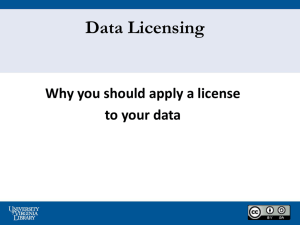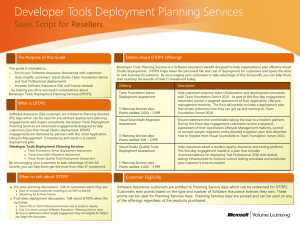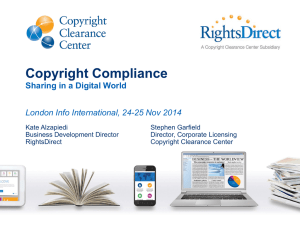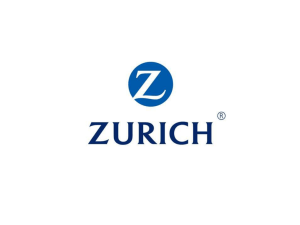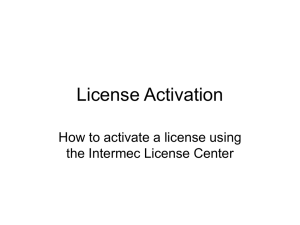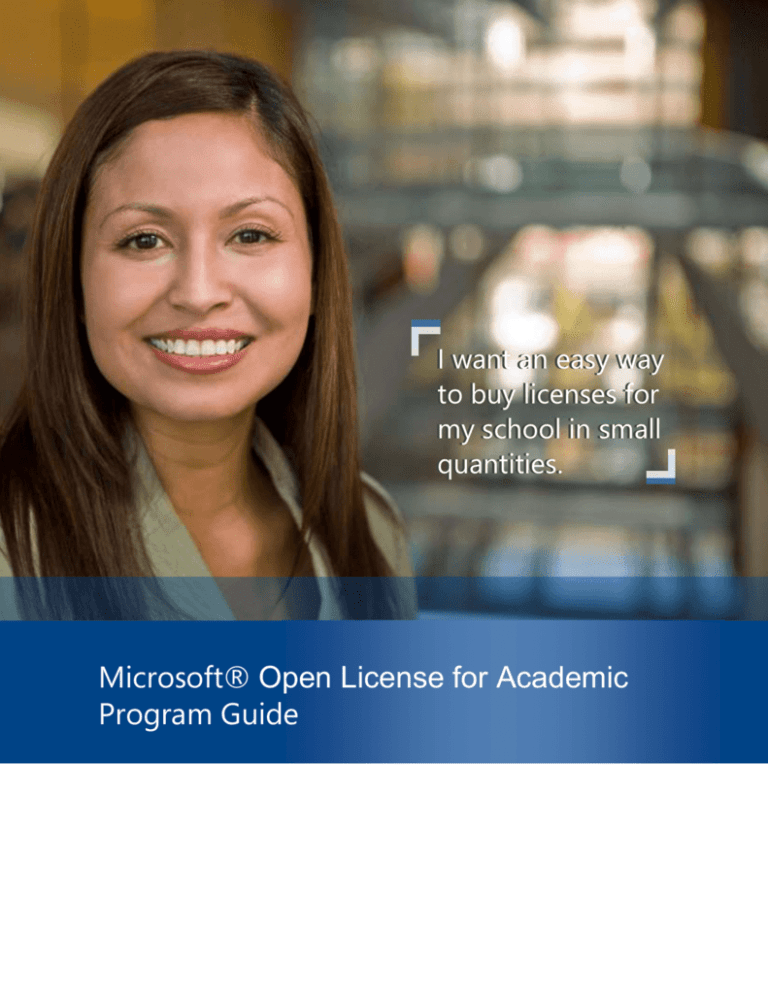
I want an easy way
to buy licenses for
my school in small
quantities.
Microsoft® Open License for Academic
Program Guide
Table of Contents
Table of Contents ............................................................................................................... 2
Introduction ........................................................................................................................ 3
Academic Volume Licensing Overview
3
Open License for Academic Features and Benefits ......................................................... 4
Open License for Academic Value
5
Acquiring Licenses Through Open License for Academic .............................................. 5
Minimum Initial Order
5
Additional Orders
5
Reorders Under the Authorization Number
5
Licensing Windows Upgrades through Open License for Academic
6
Software Assurance With Open License for Academic ................................................... 6
How Software Assurance Works
6
Purchasing Software Assurance
7
Tracking Licenses with eOpen .......................................................................................... 7
eOpen Benefits
8
How eOpen Works
8
Open License Software Assurance (SA) Evaluator
9
Glossary ............................................................................................................................ 10
2
Introduction
This guide provides information to help you understand the Microsoft® Open License for Academic
licensing program and deploy and manage your software licenses. It is provided for informational purposes
only. Your licensed product use is governed by the terms of your licensing agreement. The Microsoft
Licensing Product Use Rights (PUR) document, which is updated regularly, provides additional details
regarding current use rights for specific Microsoft products acquired through Volume Licensing programs.
For a copy of the current PUR, please go to http://www.microsoft.com/licensing/userights/.
Academic Volume Licensing Overview
For education customers who license software in quantity and manage software across multiple computers,
Microsoft Volume Licensing programs may provide the most cost-effective way to acquire licenses.
Microsoft offers both “subscription” and “transactional” volume licensing programs for education
customers.
Subscription Licensing
With subscription licensing programs, you have the right to run a selection of products, and any upgrades
or downgrades of those products, for a designated term. For application, system, and Client Access License
(CAL) products, even if the number of computers or users grows, you remain fully licensed throughout the
designated term, and you only need to report increases on your annual order.
Microsoft has two subscription licensing programs for education customers. Campus Agreement is for
higher-education institutions and offers the simplicity of counting people instead of computers. School
Agreement is for K-12 schools and preschools and makes it easy to license all of a school’s computers by
counting them just once per year.
Subscription licensing offers many benefits, including:
3
Easy compliance. Because all of your school’s computers and users are covered throughout the
subscription term, it is easy to ensure that your school is fully licensed for the products you have
selected.
Low administration. Subscription licensing helps eliminate the need to track licenses for the
selected licensed products on every computer. This is especially helpful for managing licensed
product assets in a decentralized environment.
Current technology. With subscription licensing, your licensed users can run the most current
version of the licensed products included in your subscription.
Simple budgeting and purchasing. One annual payment covers all of the licensed products you
have selected for the year.
Excellent value. By standardizing on a platform of products, you reduce your total cost of
ownership while helping to increase productivity and access to current technology. Software
Assurance Membership—including support resources, tools, and E-Learning courses—is included
with your license coverage at no additional charge. You also receive one complimentary MSDN®
Academic Alliance or MSDN Academic Alliance High School membership.
Transactional Licensing
With transactional volume licensing programs, you acquire perpetual software licenses (meaning your
institution has a perpetual, everlasting license) while eliminating the costs and packaging of retail software.
Microsoft has three transactional volume licensing programs for education customers: Microsoft Open
License for Academic, Microsoft Select License for Academic, and Microsoft Select Plus for Academic.
Open License for Academic
Open License for Academic is a widely accessible and cost-effective way for small education institutions to
license Microsoft software, starting with as few as five licenses. You simply determine the number of
software licenses your institution wishes to acquire and place the order with an authorized reseller. You also
have the option to include Software Assurance with your licenses. After obtaining licenses, you can order
installation media from a Microsoft-approved fulfillment source for a fee. License confirmations are
distributed electronically and posted on a password-protected Internet site.
Select License for Academic
Select License for Academic provides volume licensing for medium and large institutions with approximately
250 or more PCs who are able to forecast their license needs over a three-year period. Each product within
Select License for Academic has an assigned point value, which allows your institution to establish a special
Academic price level by meeting a minimum forecast of license acquisitions.
With Select License for Academic, you can add Software Assurance to an individual license, or you can select
Software Assurance Membership (SAM) for an entire pool of products. You can also pass on the savings of
Select License for Academic to your students by including a Student Select enrollment with your Select
License for Academic agreement. Select License for Academic is available through an Authorized Education
Large Account Reseller (LAR). To locate a LAR in the U.S. or Canada, please visit
http://www.microsoft.com/education/LARs.mspx.
Select Plus for Academic
Select Plus for Academic is the newest transactional program for medium and large institutions with
approximately 250 or more PCs. Select Plus for Academic offers the advantages of a non-expiring
agreement, the flexibility to acquire licenses as needed, a single customer ID to streamline account
management across multiple affiliates, student licensing through Student Select Plus, and the ability to add
value with a full 36 months of Software Assurance. Select Plus for Academic is available through an
Authorized Education Large Account Reseller (LAR). To locate a LAR in the U.S. or Canada, please visit
http://www.microsoft.com/education/LARs.mspx.
Open License for Academic Features and Benefits
Microsoft Open License for Academic is a smart choice for great value on Microsoft software. Created for
smaller education institutions, this flexible licensing program offers savings on retail Microsoft software,
while giving you the full benefits of an innovative volume-based licensing program. The Open License for
Academic program is designed to provide an easy way for you to acquire and administer multiple copies of
software and receive license confirmations quickly and conveniently. You can obtain the most current
Microsoft software products for your institution while helping to manage overall costs and staying
compliant.
4
Open License for Academic Value
Simplicity – Open License for Academic is easy to understand and administer with simple, clear
terms for acquiring software licenses.
Flexibility – Open License for Academic is flexible enough to meet the needs of a broad range of
institutions. Customers can choose from a wide selection of products. After an initial order of five or
more licenses, you may place orders for as few as one license, so you order only what you need.
Availability – You can acquire Microsoft products through Open License for Academic from any
Authorized Education Reseller (AER).
Compliancy – With eOpen, you receive license confirmation information electronically and you can
quickly and easily view your license purchase history—so there’s never any question about what
licenses you own.
Acquiring Licenses Through Open License for
Academic
Minimum Initial Order
In order to initiate an Open License for Academic agreement, there is a minimum acquisition requirement of
five licenses. This may include licenses in any combination of products. When your acquire a license with
Software Assurance (L+SA), it counts as two licenses toward your 5 lincense minimum order.
Additional Orders
There is no minimum requirement for additional orders, so you can submit orders for as few as one license
and receive the volume discounted price established by your Open License for Academic agreement.
Reorders Under the Authorization Number
The authorization number is assigned by Microsoft when you initiate a new Open License agreement (or
initial order). The authorization number is used for reorders, affiliate purchasing, and license tracking.
Initial orders under an
Open License Agreement
Additional orders under an existing
Open License Agreement
Contract Term
Two year term begins with each new
order on a new authorization number
Two-year term begins with initial order only
Online (eOpen)
tracking
Set up a new logon to view licenses
online
Return to eOpen using current logon to view
additional licenses purchases
Parent/Subsidiary &
Affiliate relationship
Parent or other related entity must
place initial order to set price level
Parent or affiliate may use same authorization
number for reorders
Minimum Order
Quantities
5 licenses
1 license
5
Software Assurance
Customer has full two-year coverage
from initial order
Customer length of coverage expires at the
end of the authorization number started with
the initial order
Licensing Windows Upgrade through Open License for Academic
When you license a desktop operating system through Microsoft Volume Licensing programs, it’s important
to understand that only UPGRADE licenses for Windows are available—FULL operating system licenses are
not offered. Prior to licensing a Windows Upgrade through your Open License for Academic agreement, you
need to have a full underlying license for a qualifying operating system for each PC. (Qualifying operating
systems are listed in the Microsoft Volume Licensing Product List, which you can find at
http://www.microsoftvolumelicensing.com/userights/PL.aspx.) There are two ways for you to get the
necessary full operating system license:
1.
For newly manufactured PCs, the best way to acquire that license is to have the Original Equipment
Manufacturer (OEM) pre-install Windows on the PC.
2.
If the OEM has not pre-installed Windows on the PC, then you can purchase a full Windows license
through retail full packaged product (FPP).
If you discover that you have existing PCs that lack the necessary full license for a qualifying operating
system, talk to your Microsoft reseller about the Get Genuine Windows Agreement for Academic (GGWA-A).
GGWA-A provides a simple, cost-effective way for you to acquire full licenses for Windows Vista Home
Basic. These licenses fulfill your requirement for a full qualifying operating system. Once you have acquired
the full operating system license, you are then eligible to license those PCs for Windows Vista Business
Upgrade* through your Open License for Academic agreement. Learn more at
http://www.microsoft.com/piracy/knowthefacts/LegalizationSolutions.aspx.
Software Assurance With Open License for
Academic
When you include Software Assurance with licenses acquired through Open License for Academic, you
acquire the right to install any new release of covered products during the term of the Open License for
Academic authorization number under which Software Assurance was purchased. You also qualify to receive
eLearning content. Learn more about the benefits of Software Assurance at
www.microsoft.com/education/softwareassurance.aspx.
How Software Assurance Works
Software Assurance (SA) is a great value for institutions who value the ability to deploy and update solutions
based on the most recent technology releases.
Once purchased, SA enables you to take advantage of technology advancements available through future
version software products released during the term of your Open License for Academic authorization
number. This advantage also applies to older version software, which offers you additional flexibility in
deployment of solutions that meet your needs.
6
Purchasing Software Assurance
You may purchase Software Assurance (SA) with a license by ordering License & Software Assurance (L&SA).
SA coverage runs for two years or the remaining balance of the term of the Open License for Academic
authorization number. SA must always be paid for in two-year increments, regardless of when it was
purchased. In cases where time has passed after the initiation of an Open License for Academic, it may be
advantageous for you to open a new Open License for Academic agreement in order to receive the most
value from you SA purchase.
You may also be acquire Software Assurance on its own when:
System or server software product licenses are acquired through retail full-packaged product (FPP)
or from an original equipment manufacturer (OEM). There is a 90-day enrollment period during
which time Software Assurance may be added to these purchases.
Microsoft Office 2003 or newer version licenses are acquired through an OEM. Again there is a 90day enrollment period during which time Software Assurance may be added to these purchases.
Start of a new Open License for
Academic License authorization
number
End of the two-year
authorization number
2-year authorization
number
Start of year 2
Acquire the License & Software
Assurance (L&SA) package for any
product any time during the term
Receive upgrades for the remainder of the
term of the authorization number
Please note: In Open License for Academic, SA is only available at a two-year price.
Tracking Licenses with eOpen
Microsoft provides electronic delivery of Open License for Academic through the eOpen Web site at
https://eopen.microsoft.com in countries where electronic license delivery is available. eOpen is a
proprietary Web-based solution that reflects our record of the license status of all Open License for
Academic customers. The secured license site has been developed to help manage Open License for
Academic acquisitions. With each acquisition, a customer will receive access to the secured site to view the
Open License for Academic status, license data, acquisition and return details, Open License for Academic
agreements, and other Open License for Academic information.
7
eOpen Benefits
Immediate authorization to begin copying software and deploying software licenses
Ability to electronically track transactions online
Easy access to transaction history, including acquisitions, reorders, and returns
Reduction of administrative costs associated with manually tracking license certificates and software
compliance
Utilization of the Internet to take advantage of online technology
How eOpen Works
When Microsoft accepts an Open License for Academic order, the authorization and license numbers are
created and posted to eOpen within 24 hours, giving a view of our record of the customer’s license status.
Order and license status include:
Authorization number
License number
Name and address of end user
Date of initial order
Expiration of authorization number (last day to reorder)
Products and quantity ordered
Customer
Place Order
Customer views
licenses on the
Web site
Reseller
Place Order
Distributor
Place Order
eOpen Site
8
Post License
Microsoft
Open License Software Assurance (SA) Evaluator
The Open License Software Assurance Evaluator on https://eopen.microsoft.com can assist you in
determining the most cost-effective method for purchasing SA.
The tool summarizes Open License purchases in the current eOpen view. The products are then grouped
into four categories:
Not Current – Indicates licenses maintained for a previous version of a product.
Current without Upgrade Advantage – Indicates licenses maintained for a current version of the
product, but not rights to new releases.
Current with Upgrade Advantage – Indicates licenses maintained for a current version of the
product and rights to versions of that product released during the Upgrade Advantage period.
Not Analyzed – The tool is not equipped to analyze every situation. In this case, please speak to a
reseller for appropriate analysis.
Once categorized, the tool will provide options on how products in the first three categories can be covered
by SA. Once the licenses have been analyzed, save the analysis and share it with a reseller to determine the
best course of action. The tool is currently available in English, French, German, Italian, Japanese, Korean,
Brazilian Portuguese, and Spanish.
9
Glossary
Affiliates
A company or legal entity that owns, is owned by, or is under common ownership with the customer.
Authorization number
The number assigned to the customer by Microsoft after initiating an Open License for Academic account.
This number allows for reorders for two years.
Authorized Education Reseller
A reseller that is authorized to sell Microsoft Academic Edition (AE) products to eligible academic customers.
Distributors
An organization authorized by Microsoft to distribute Microsoft products to resellers.
eOpen
A secured proprietary Web-based site that provides Open customers access to Open License for Academic
account information.
L&SA
See License & Software Assurance Package.
License
The license that grants a customer the right to run a Microsoft software product as specified in the product
use rights.
License & Software Assurance Package
The part number that combines the License and Software Assurance part numbers.
Microsoft
Microsoft Corporation or any of its affiliates.
Open License
In relation to Microsoft volume licensing, Open License is a volume license program for customers with a
need for as few as 5 licenses. Open License refers to the rules and procedures of this acquisition option or
to the software products acquired and to the agreement that grants rights to use the products depending
on the context.
Product list
A document listing all Microsoft products available for acquisition under the Open License for Academic.
Product pools
Microsoft products available through Open License for Academic are categorized as applications, systems,
and server products.
Reseller
Any organization providing the resale of Microsoft products to a customer.
10
SA
See Software Assurance.
Software Assurance
The comprehensive Microsoft maintenance program.
© 2009 Microsoft Corporation. All rights reserved. Microsoft, Microsoft Dynamics, BizTalk, FrontPage, OneNote, SharePoint, SQL Server,
Visio, Windows, Windows Server, Windows Vista are either trademarks or registered trademarks of Microsoft in the United States
and/or other countries.
This document is for informational purposes only. MICROSOFT MAKES NO WARRANTIES, EXPRESS OR IMPLIED, IN THIS SUMMARY.
Microsoft provides this material solely for informational and marketing purposes. Customers should refer to their agreements for a full
understanding of their rights and obligations under Microsoft’s Volume Licensing programs. Microsoft software is licensed not sold.
The value and benefit gained through use of Microsoft software and services may vary by customer. Customers with questions about
differences between this material and the agreements should contact their reseller or Microsoft account manager. Microsoft does not
set final prices or payment terms for licenses acquired through resellers. Final prices and payment terms are determined by agreement
between the customer and its reseller. Eligibility for Software Assurance benefits varies by offering and region and is subject to
change. The Terms and Conditions of your Volume License Agreement and the Terms and Conditions under which any specific
Software Assurance benefits are offered will take precedence in the case of any conflict with the information provided here. For
eligibility criteria and current benefit program rules, see the Microsoft Product List
The contents of this guide are subject to change. Please contact your Microsoft account manager or reseller for the most current
version of this guide.
0609
11

